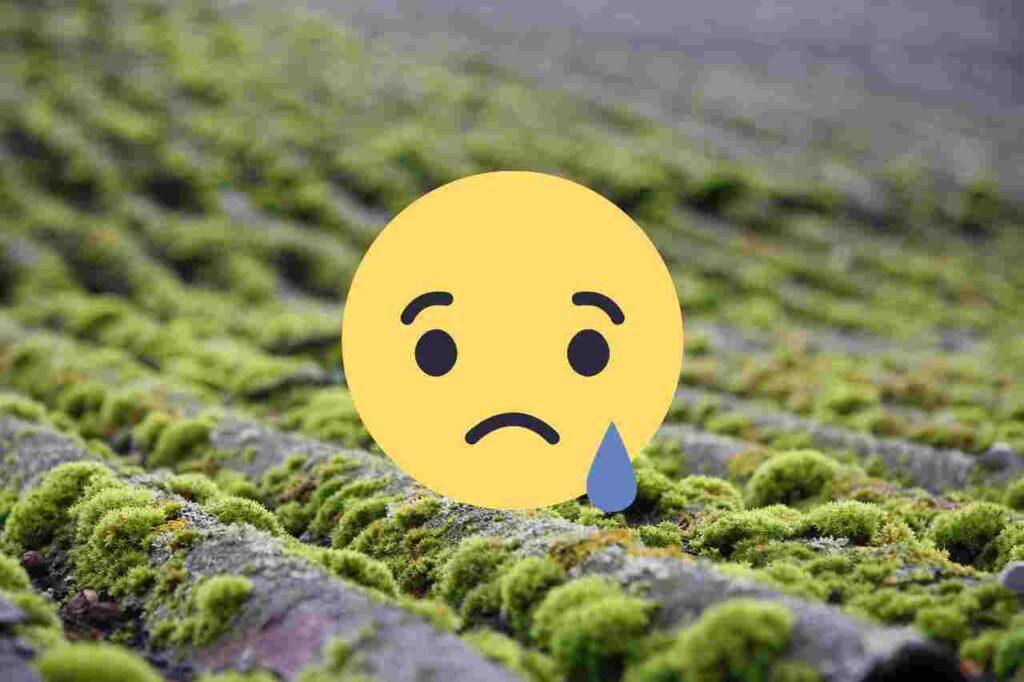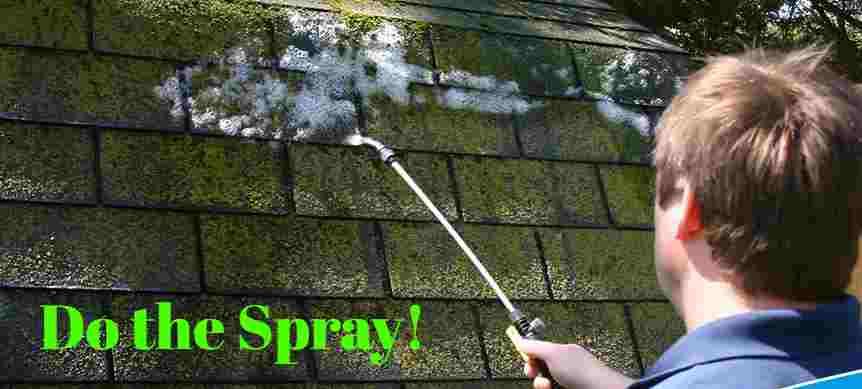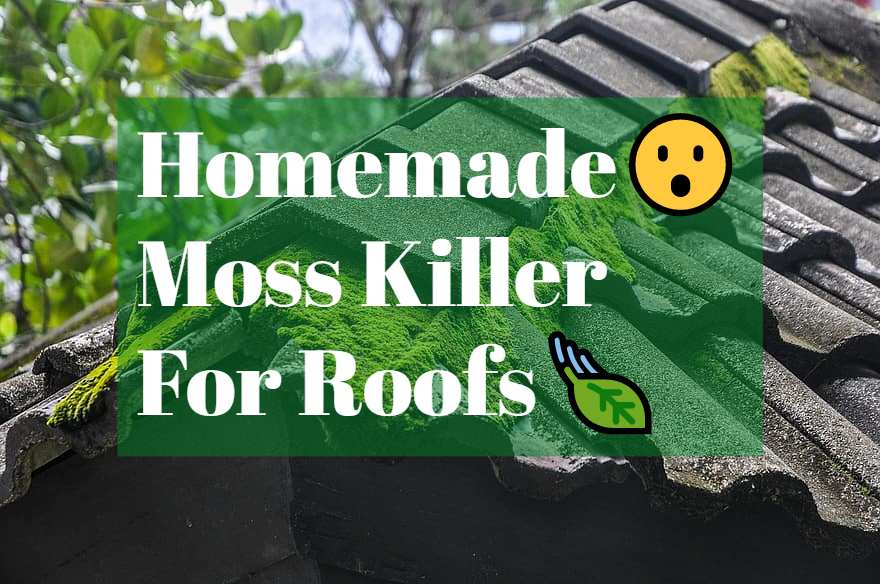The Best Ways To Remove Moss On Roof:

Doesn’t it appear a bit dreamy, a rustic and cozy layer of green on your rooftop? Well, even if it did, it is extremely bad for your roof. Moss is known to flourish in a shady and damp environment, you might have seen them grow on the northern side of your rooftop.
This area receives the least amount of sunlight. Moss is the reason behind the degradation and decay of roofs. Moreover, if you are on the roof for inspection or fixing it and if the roof is filled with moss then this becomes risky for you.
Cause moss makes the roofs slippery and walking on the roof without slipping becomes a challenge. So let us teach you how to make homemade moss killer for roofs in an easy way.
Contents
The Benefits Of Diy Moss Killer Solution
Moss on the roof can be a significant problem, causing aesthetic deterioration, blocked gutters, and even structural damage. Fortunately, there are several ways to remove moss from the roof, including homemade solutions. In this section, we’ll discuss the benefits of using diy moss killer solutions.
Discuss Why Diy Moss Killer Solutions Are Better Than Other Alternatives
When it comes to removing moss on the roof, several options are available, including hiring a professional, using chemicals, or making your diy moss killer solution. Here are some reasons why diy solutions are better than other alternatives:
- Chemical treatments can harm the environment and damage your roof’s surfacing, while diy solutions use natural ingredients that are environmentally friendly and safe.
- Professional services can be expensive, while a diy solution can be made with ingredients easily available in most homes.
- Diy solutions give you control over the ingredients you use, which enables you to ensure they don’t cause any harm to the environment or damage your roof.
Mention The Cost-Effectiveness Of Diy Solutions
Using a diy moss killer solution can save you a lot of money. Professional roof cleaning services can charge hundreds of dollars, while a diy solution can be made using everyday ingredients such as vinegar, baking soda, and salt. These solutions can be made for a fraction of the cost of the commercial alternatives.
Highlight The Environmental Benefits Of Diy Solutions
Diy moss killer solutions are environmentally friendly and safe. The ingredients used in the solutions are natural and do not harm the environment. There is no need to introduce unnecessary chemicals into the ecosystem when tackling a moss problem on the roof.
As a bonus, diy moss killer solutions are also free of toxic fumes, making them safe for people and pets.
Diy moss killer solutions are a great option for people who wish to remove moss from their roof quickly, cost-effectively and in an environmentally friendly way. Before deciding which moss removal method to use on your roof, make sure to weigh the pros and cons of each option and choose the one that best fits your needs and values.
Understanding Moss On Roofs
Moss growth on roofs is a common issue that needs to be addressed. Moss spread on the roof can destroy and reduce the lifespan of your roofing materials. It is essential to understand moss on roofs to prevent damage to your roof.
Here are some factors to consider for moss growth on roofs.
Discuss The Factors That Lead To The Growth Of Moss On Roofs
- Environment: Trees and other plants provide the perfect condition for moss growth. When the roof is in a moist and shady environment, the roof is more susceptible to moss growth.
- Roof age: As old roofs gets more porous, they can absorb more water, retaining moisture and making it more prone to moss growth.
- Moisture: Accumulation of moisture on the roof can cause moss to grow. This includes rainfall, snow, and condensation.
- Roof design: Roof design can have an impact on moss growth, especially for roofs with ridges and valleys that are prone to retaining moisture.
Highlight The Dangers Of Moss Growth On Roofs
Moss may seem like a harmless plant, but it can pose a significant threat to the roof of your home. Some of the dangers include:
- Reduced lifespan: Moss spreads throughout the roof, retaining moisture and damaging the roofing materials. This can cause the roof lifespan to reduce, and eventually causing leaks.
- Safety hazard: Mossy roofs can be slippery and increase the chances of accidents especially, if left untreated.
- Health hazard: Moss can harbor spores that can cause respiratory problems when breathed.
Detail The Different Types Of Moss That Can Grow On Roofs
There are three main types of moss that grow on roofs. Each type of moss can cause different types of damage if left unattended:
- Plagiothecium: This moss grows in dense tufts, spreads fast, and collects rainwater, leading to potential water damage.
- Hypnum: This type of moss has a yellowish-green color and thrives on tiles and wood roofs. If left unchecked, it can cause rotting, leading to water damage and leaks.
- Polytrichum: Polytrichum is a hairy-looking moss that may grow in various colors of green, brown, and yellow. It holds a significant amount of water and can cause excessive moisture retention, leading to shingle damage.
Understanding moss on roofs may help homeowners identify and prevent damage before it happens. Regular cleaning and maintenance can slow down the growth of moss, extending the life span of your roof while protecting your home.
How to remove moss on the roof?
Method 1-Get Started With The Hose
Before you get started with the task, remember to maintain caution. You must wear old clothes, slip-resistant shoes, eye protection, rubber gloves, and a cap. Carefully place the ladder close to the region of the roof where there is moss growth. Try to secure your position with the use of a safety rope. Begin the cleaning procedure by spraying the moss-covered region with water. Keep in mind to angle your hose in a downward direction.
Time To Scrub The Moss
Make the most of your soft-bristled, long-handled scrub brush. Start scraping the moss from the tiles or shingles. Try to focus on a small section and then proceed to move to the other. This will enable you to clean swiftly and save time. You must move your brush carefully and in a downward motion, this is crucial if you wish to save your tiles from breaking. Never make the mistake of using high-powered water jets on your roof.
Bring Out The Moss Cleaning Solution
If your moss problem remains unaffected after the use of water and scrubbing, then it is time to pull out the big guns, in this case, it is a cleaning solution. You must look for a cloudy day to get this done. Sunny days will quickly evaporate the cleaning solution.
Spread a plastic sheet on the roof to prevent sides, pathways, or decks from discoloration. It will also protect sensitive plants. It is easy to get your hands on an effective moss removing solution. You can even make your own moss killer for roofs.
Add a pound of powdered oxygen bleach to 2 gallons of water. This is one of the easiest homemade moss killer recipes.
- In order to get started, use plain water to clean your roof.
- While the roof is still wet spray the cleanser on the affected area and lets it rest for at least 30 minutes.
- Using the soft-bristled, long-handled brush scrub the roof properly. Rinse it with water.

Method 2
You can make your Homemade moss killer using four household ingredients: water, vinegar, salt, and soap.
- T first add 1 gallon of clean warm water to a bucket.
- Then add 1 tablespoon of vinegar and 1 pound of salt. Then stir it properly
- You can add as much soap as you want, as long as it doesn’t cover up more than 20 percent of the total warm water and vinegar solution.
- Each ingredient serves their individual purpose. That’s why you must mix the right ratio of ingredients for the moss killer solution to be effective.
- The water is used in this solution as a diluter, which makes the application of the moss killer easier. The vinegar and salt bring out moisture from the moss and f*ck it up nicely.
- Adding soap as additional to the mixture makes the solution like a gangsta solution and helps the moss killer suck up the moss even more easily, which finally increases the chances of killing it.
Application
First thing first! You have to take precautions before applying the homemade moss killer on your roof.
Fill the solution in a spray bottle and spray the affected areas.
- You should spray enough so that the solution on the moss can dampen it.
- The salt and vinegar in the mixture can be very problematic. It ain’t give a damn and will kill any plant it touches. I would rather say it’ll f*ck any plant it touches. So avoid spraying the solution onto flowers and plants, including fruits and vegetables, unless you really wish to get rid of them or make your wife compel you to sleep on the couch! Give the solution a few days to work, as it takes time.
Read also: How To Walk On A Metal Roof Without Slipping
How Can You Prevent Moss From Returning To Your Rooftop?
Now that you’ve cleaned your roof from moss, it is imperative to think about the next step. What will you do to prevent moss from coming back?
- Sunlight is the best way to fight moss. Try to trim the branches of the trees hanging close to your roof.
- You must make sure that your gutters are always clean and there is no sign of twigs, leaves, or mud.
- Place copper or zinc-coated sheets below the peak of your roof. This will kill moss when it rains and there will be no signs of moss.
If you are tired of a green, moss-covered roof then we have the best ways that you can remove them. Are you ready to get to work?
Frequently Asked Questions
What Causes Moss To Grow On Roofs?
Moss grows on roofs due to dampness, shade, and lack of sunlight. It also thrives on surfaces that accumulate debris, dirt, and organic matter.
What Is The Best Homemade Moss Killer For Roofs?
The best homemade moss killer for roofs is a mixture of equal parts of white vinegar and water. Apply the solution to the affected area and let it sit for at least 30 minutes before rinsing off.
Is Moss On The Roof Harmful For The House?
Yes, moss on the roof can be harmful to the house. It can trap moisture, causing damage to the roof’s shingles, tiles, or other materials. It can also act as a breeding ground for pests and insects.
How Often Should I Remove Moss From My Roof?
Ideally, moss should be removed from the roof once a year, preferably in the fall. Regular maintenance can prevent moss from growing excessively and causing damage to the roof.
Will Removing The Moss Damage The Roof?
No, removing moss from the roof will not damage it if done correctly. Avoid using pressure washers or hard-bristled brushes as they can damage the roof’s surface. Use a gentle approach and a moss scraper to remove the moss.
Conclusion
To sum it up, removing moss on the roof is an important task to maintain the longevity and sturdiness of your roofing system. Neglecting or delaying the moss removal can cause severe damage to your roof. However, you don’t need to spend a fortune on hiring professional roof cleaners or using chemical agents.
The homemade moss killers mentioned above can effectively remove moss without compromising the environment or your budget. It only requires some common household ingredients, patience, and effort to get the desired results. Adding regular roof maintenance and cleaning to your routine can help you avoid any moss and algae buildup in the future.
With these tips, you can ensure your roof remains moss-free and safe for years to come.
Read also: Best Shoes For Roofing


2 thoughts on “Homemade moss killer for roofs: 2 Methods Of Removing Moss”